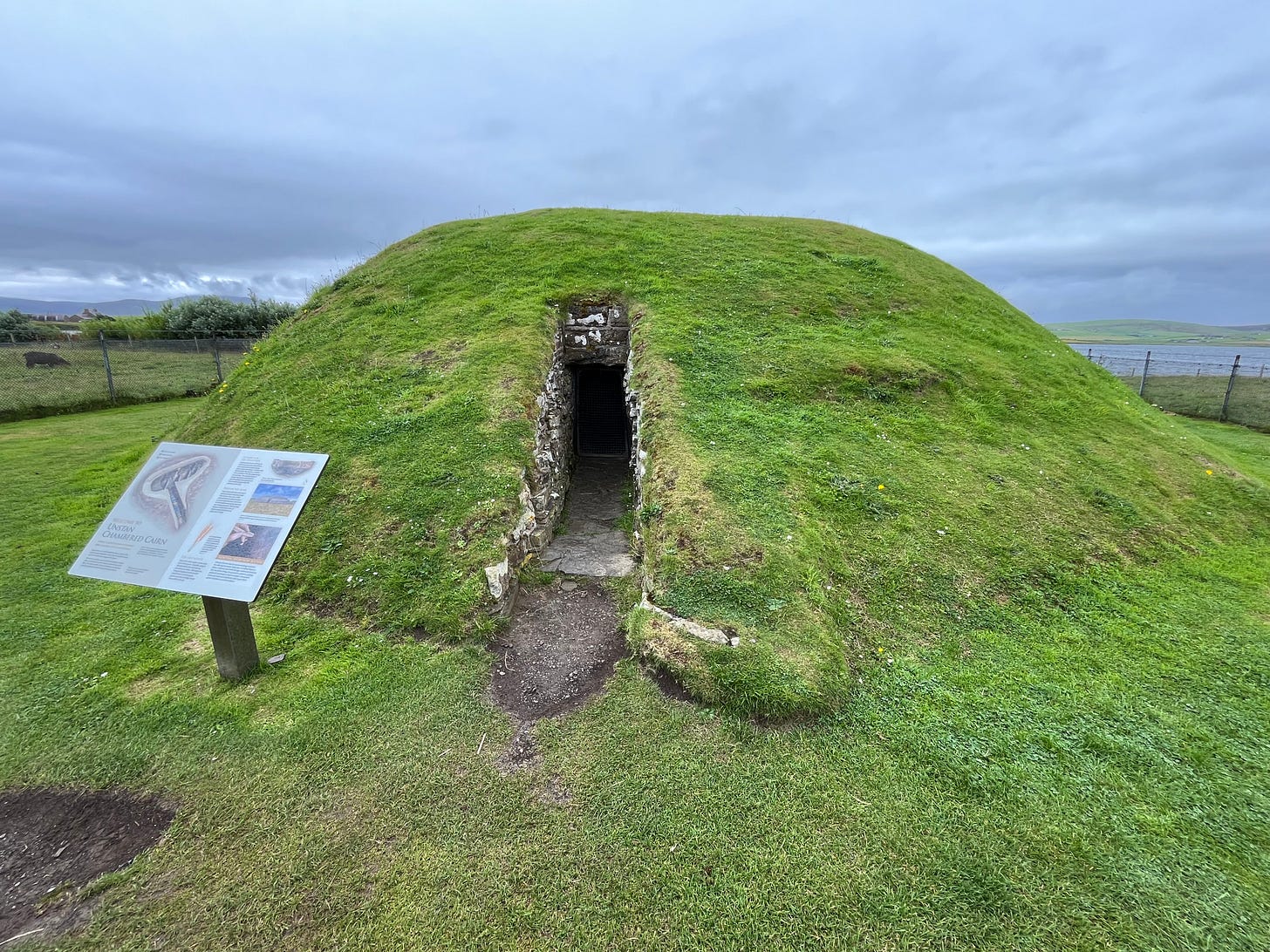Over the course of a month, whilst away from home, I have been slowly reading Kathleen Jamie’s latest work, Cairn, which I have reviewed here. It seemed only fitting therefore, to include some writing about two cairns I visited whilst on Orkney.
The most famous of these cairns and considered one of the ‘must see’ four hearts of Neolithic Orkney is Maeshowe. Aligned with the midwinter sunset, its enigmatic presence, overlooks the Stones of Stennis. You can only see the inside of Maeshowe with a guided tour, so are reliant on the guide to explain various theories and show you one or two of the many Runic scripts that were written in the eleventh century by a band of Vikings sheltering from a storm. The cairn, dated to approx 2800 BCE, is a unique aptly named Maeshowe type Cain only found within Orkney. It is one of the largest Corbeled cairn at a height of twenty four feet. It has a long low entrance passage which has been compared to the Pyramids in its stylisation.
Standing just a short distance away from Maeshowe on the edges of the village of Stennis is Unstan chambered cairn. Known as a stalled cairn because the inside is seemingly sectioned in places by two large standing stones, Unstan is far older than Maeshowe being built around 3400 BCE. Several pieces of pottery, now known as Unstan wear was discovered in pieces along with two crouching skeletons.
Inside Unstan the roof has been completely reconstructed in the 1930s which has led to a problem with green algae.
Since my experience at Camster on mainland Scotland, (see previous blog post about this amazing set of cairns,) I have reconsidered how we enter cairns. At both these sites interestingly, the entrance is much higher. Does this suggest a different funeral practice where supplication to the dead was not required? Or perhaps, the entrances have been reconstructed to suit the sensibilities of modern visitors? Inside Unstan it is hard to feel any form of connection or disconnection from the outside world, due to the reconstructed roof giving it an unnaturally modern atmosphere. Sadly due to the amount of people crammed into Maeshowe at once on the tours, it is impossible to fully immerse yourself in the past.
Even so, standing in these two cairns; one with an artificial top and one artificially protected, you cannot fail to be impressed by the craftsmanship of our Neolithic and Bronze Age ancestors.
Cairn by Kathleen Jamie is a mixture of non fiction micro-essays, personal notes, fragments and beautiful prose poems. Although only a slim volume, it is nevertheless a proud meditation on the fragility of nature.
“I can imagine a world going on without me..” Jamie wrote as she turned 60. Here she has created a memorial about the natural world, Scotland, and environmental dangers facing them - a paper cairn if you will. Filled with wonderful glimpses into the unnoticed in our modern tech-heavy busy lives.
Her expressions of this fleeting beauty are sublime; for example, “now a blackbird flees urgently over rooftops, like an innocent who has suddenly understood..” And there are many more phrases like this that bring both a deep sense of longing and a tear or two.
As a fan of Jamie for many years, I appreciate her visionary viewpoint and often refer back to her earlier works when looking at how to see elements of the world in new and refreshing ways. As fragmented and imperfectly formed some of the pieces in Cairn are, they offer a subtle snapshot into what makes the great writer tick. All together they create a fitting landmark.
A rare thing these days.








